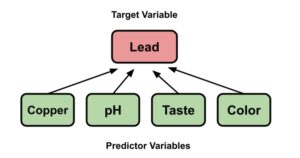As part of an EPA-funded project, the STSA lab used existing data to build models that predict lead in tap water. Here’s how we did it.
 The Virginia Household Water Quality Program (VAHWQP) collected water samples and conducted household surveys at households that use private water systems, such as well water, during 2012 and 2017. These efforts generated a rich dataset of nearly 10,000 samples that we can use to develop statistical models to predict lead in water.
The Virginia Household Water Quality Program (VAHWQP) collected water samples and conducted household surveys at households that use private water systems, such as well water, during 2012 and 2017. These efforts generated a rich dataset of nearly 10,000 samples that we can use to develop statistical models to predict lead in water.
We used a statistical model building approach, Bayesian Belief Networks, to develop models that predict lead in water.
A Bayesian Belief Network predicts lead in tap water using inputs including observations of water quality, such as discoloration and taste, other water quality parameters, such as copper and pH. The dataset collected at private water systems in Virginia by the VAHWQP was used to train the Bayesian Belief Network models.
Bayesian Belief Models use water quality parameters as input to predict lead.
 Some of these water quality parameters can be measured using water test kits at home. People who want to estimate their risk of lead can test their water at home for water quality parameters, such as pH, iron, and copper. Users can purchase inexpensive water quality test kits and follow instructions, such as:
Some of these water quality parameters can be measured using water test kits at home. People who want to estimate their risk of lead can test their water at home for water quality parameters, such as pH, iron, and copper. Users can purchase inexpensive water quality test kits and follow instructions, such as:
- Fill a test container with a water sample, dip a test strip in, swirl the container, and wait a few minutes with the test strip resting in the water sample.
- Take the strip out of the water and compare the color changes on the test strip to a color chart included in the kit.
Our collaborators created a new website that uses the Bayesian Belief Network models to predict lead based on inputs that are entered by users – including the results of at-home water quality testing.
 When users enter their plumbing characteristics, water quality readings from at-home test kits, and observations of water quality, the Bayesian Belief Network calculates the risk of lead and reports that to the user. This interactive tool provides a way for citizen scientists to learn about the risk of lead in tap water. On-going research is exploring the reliability and accuracy of at-home water quality test kits.
When users enter their plumbing characteristics, water quality readings from at-home test kits, and observations of water quality, the Bayesian Belief Network calculates the risk of lead and reports that to the user. This interactive tool provides a way for citizen scientists to learn about the risk of lead in tap water. On-going research is exploring the reliability and accuracy of at-home water quality test kits.
